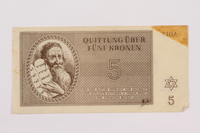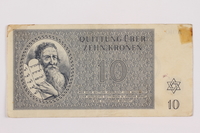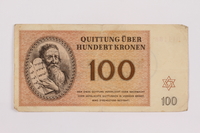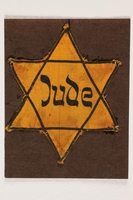Overview
- Brief Narrative
- Scrip, valued at 2 kronen, issued in the Theresienstadt (Terezin) ghetto-labor camp in 1943. All currency was confiscated from deportees upon entry and replaced with scrip and ration coupons that could be exchanged only in the camp. The Theresienstadt camp existed for 3.5 years, from November 24, 1941 to May 9, 1945. It was located in a region of Czechoslovakia occupied by Germany, renamed the Protectorate of Bohemia and Moravia, and made part of the Greater German Reich.
- Date
-
issue:
1943 January 01
- Geography
-
issue:
Theresienstadt (Concentration camp);
Terezin (Ustecky kraj, Czech Republic)
- Credit Line
- United States Holocaust Memorial Museum Collection, Gift of Ruth Binder
- Markings
- front, upper center, printed in red ink : QUITTUNG ÜBER / ZWEI KRONEN [RECEIPT OF / TWO CROWNS]
front, lower center, printed in middle text then above in red ink : 2
front, lower center, smaller text than above, printed in red ink : WER DIESE QUITTUNG VERFÄLSCHT ODER NACHMACHT / ODER GEFÄLSCHTE QUITTUNGEN IN VERKEHR BRINGT. / WIRD STRENGSTENS BESTRAFT [ANYONE WHO FALSIFIES OR DISTORTS OR FAKES THIS RECEIPT, OR COUNTERFEITS RECEIPT, WILL BE STRICTLY PUNISHED]
reverse, upper left in border, plate letter and number, printed in red ink :
reverse, center, printed in red ink : Quittung / über / ZWEI KRONEN [Receipt / of / TWO CROWNS]
reverse, lower center, printed in red ink : THERESIENSTADT, AM 1.JANNER 1943 DER ALTESTE DER JUDEN / IN THERESIENSTADT [THERESIENSTADT, ON 1. JANUARY 1943 THE ELDER OF THE JEWS IN THERESIENSTADT]
reverse, bottom right, printed in red ink : Jakob Edelstein
Physical Details
- Language
- German
- Classification
-
Exchange Media
- Category
-
Money
- Object Type
-
Scrip (aat)
- Physical Description
- Rectangular paper scrip. The front has a graphic design in black and red ink on a red background. The front depicts Moses holding 2 stone tablets with the 10 Commandments in Hebrew characters within a medallion on the left, with German text on the right. The right side has a wide, off-white border with the denomination 2 in the lower corner and a 6-pointed Star of David above. The reverse has a red geometric background design with German text and a scrollwork line. Below the text is an engraved signature. The denomination 2 is in the upper right corner. The left side has a wide, off-white border with the denomination 2 in the lower corner with a 6-pointed Star of David above. The plate number is in the upper left corner.
- Dimensions
- overall: Height: 2.125 inches (5.398 cm) | Width: 4.250 inches (10.795 cm)
- Materials
- overall : paper, ink
Rights & Restrictions
- Conditions on Access
- No restrictions on access
- Conditions on Use
- No restrictions on use
Keywords & Subjects
Administrative Notes
- Legal Status
- Permanent Collection
- Provenance
- The Theresienstadt scrip was donated to the United States Holocaust Memorial Museum in 1996 by Ruth Binder.
- Record last modified:
- 2022-09-19 09:11:49
- This page:
- https://collections.ushmm.org/search/catalog/irn11822
Download & Licensing
In-Person Research
- By Appointment
- Request 21 Days in Advance of Visit
- Plan a Research Visit
- Request to See This Object
Contact Us
Also in Ruth Binder collection
Contains materials documenting the experiences of Ruth Binder during the Holocaust. Some of these materials may be combined into a single collection in the future.

Theresienstadt ghetto-labor camp scrip, 1 krone note
Object
Scrip, valued at 1 krone, issued in the Theresienstadt (Terezin) ghetto-labor camp in 1943. All currency was confiscated from deportees upon entry and replaced with scrip and ration coupons that could be exchanged only in the camp. The Theresienstadt camp existed for 3.5 years, from November 24, 1941 to May 9, 1945. It was located in a region of Czechoslovakia occupied by Germany, renamed the Protectorate of Bohemia and Moravia, and made part of the Greater German Reich.

Theresienstadt ghetto-labor camp scrip, 5 kronen note
Object
Scrip, valued at 5 kronen, issued in the Theresienstadt (Terezin) ghetto-labor camp in 1943. All currency was confiscated from deportees upon entry and replaced with scrip and ration coupons that could be exchanged only in the camp. The Theresienstadt camp existed for 3.5 years, from November 24, 1941 to May 9, 1945. It was located in a region of Czechoslovakia occupied by Germany, renamed the Protectorate of Bohemia and Moravia, and made part of the Greater German Reich.

Theresienstadt ghetto-labor camp scrip, 10 kronen note
Object
Scrip, valued at 10 kronen, issued in the Theresienstadt (Terezin) ghetto-labor camp in 1943. All currency was confiscated from deportees upon entry and replaced with scrip and ration coupons that could be exchanged only in the camp. The Theresienstadt camp existed for 3.5 years, from November 24, 1941 to May 9, 1945. It was located in a region of Czechoslovakia occupied by Germany, renamed the Protectorate of Bohemia and Moravia, and made part of the Greater German Reich.

Theresienstadt ghetto-labor camp scrip, 100 kronen note
Object
Scrip, valued at 100 kronen, issued in the Theresienstadt (Terezin) ghetto-labor camp in 1943. All currency was confiscated from deportees upon entry and replaced with scrip and ration coupons that could be exchanged only in the camp. The Theresienstadt camp existed for 3.5 years, from November 24, 1941 to May 9, 1945. It was located in a region of Czechoslovakia occupied by Germany, renamed the Protectorate of Bohemia and Moravia, and made part of the Greater German Reich.
Ruth Binder papers
Document
Contains postcards from Theresienstadt and Birkenau; Juden-Evidenzkarte, testimony relating to victims who perished at Theresienstadt; and other related materials.
Ruth Wottitzky Binder photographs
Document
Contains 98 pre-World War II and wartime photographs of the extended family of Ruth Wottizky Binder. Included are photographs of the Weigl, Spaeth, Klepetar, Wottizky, and Goldstein families who lived in Buchlovice, Moravia, and in Sevetin, Olomouc, and Tabor, Czechoslovakia. The Wottizky family managed to emigrate to the United States in 1939. The families remaining in Europe were deported to Theresienstadt and to Auschwitz; only three people survived the war.




